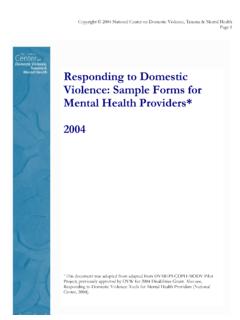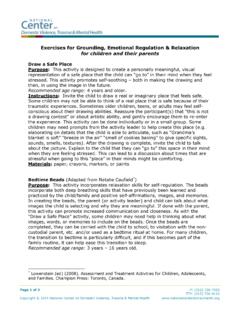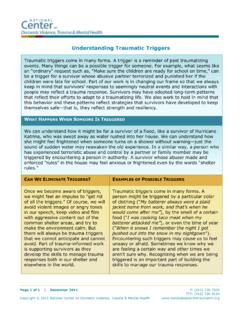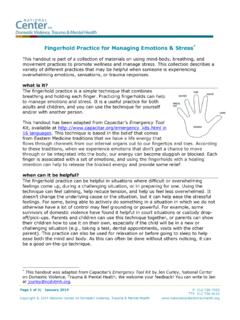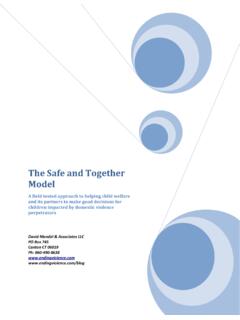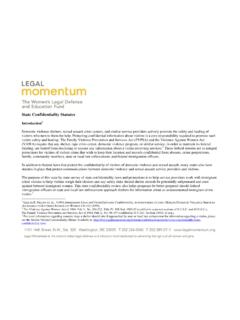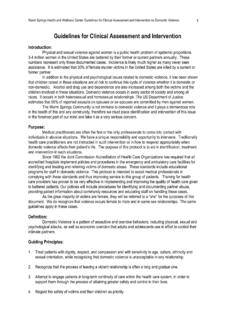Transcription of A Systematic Review of Trauma-Focused Interventions for ...
1 A Systematic Review of Trauma-Focused Interventions for domestic violence SurvivorsFebruary 2013 Carole Warshaw, MDNational Center on domestic violence , Trauma & Mental HealthCris M. Sullivan, PhDEcho A. Rivera, MAMichigan State UniversityThis report was funded through grant #90EV0417 from the Department of Health & Human Services, Administration for Children and Families, Family and Youth Services Bureau, Family violence Prevention and Services Program. Points of view expressed in this document do not necessarily represent the official position or policies of the Department of Health and Human Services.
2 The authors are grateful to Mary Ann Dutton, Marylouise Kelley, Shawndell Dawson, and members of the advisory group to the National Center on domestic violence , Trauma, & Mental Health for their extremely helpful comments on earlier drafts of this E V I E W O F T R AU M A T R E AT M E N T S F O R I P V S U R V I V O R SIntimate partner violence (IPV) is a form of trauma that can result in significant mental health distress for victims. Rates of clinical depression and posttraumatic stress disorder are higher among abused versus non-abused women, particularly if victims have experienced other lifetime trauma.
3 While there are numerous Interventions designed to reduce trauma-induced mental health symptoms, most were originally developed to address events that have occurred in the past ( , combat, childhood sexual abuse). Many IPV survivors are still under threat of ongoing abuse or stalking, which not only directly impacts their physical and psychological safety but impacts treatment options, as well. Little is known about the extent to which existing evidence-based trauma treatment modalities are applicable to, or require modification for, IPV survivors.
4 This paper, then, reviews the trauma-based treatments that have been designed or modified specifically for IPV survivors and provides cautions and recommendations for moving forward. AbstractA Systematic Review of Trauma-Focused Interventions for domestic violence SurvivorsA Systematic Review of Trauma-Focused Interventions for domestic violence Survivors2shorter in duration and less severe and they have access to resources and support (Bonanno, 2004). Others, particularly those who experience more frequent or severe abuse, may develop symptoms that make daily functioning more difficult.
5 Ongoing abuse and violence can induce feelings of shock, disbelief, confusion, terror, isolation, and despair, and can undermine a person s sense of self. These, in turn, can manifest as psychiatric symptoms ( , reliving the traumatic event, hyperarousal, avoiding reminders of the trauma, depression, anxiety, and sleep disruption). Some trauma survivors experience one or more of these symptoms for a brief period of time, while others develop chronic posttraumatic stress disorder (PTSD), a disorder that is a common response to overwhelming trauma and that can persist for years.
6 Survivors are also at risk for developing depression, which has been found to significantly relate to the development of PTSD (Cascardi, O Leary, & Schlee, 1999; Stein & Kennedy, 2001). For those who have also experienced abuse in childhood and/or other types of trauma ( , cumulative trauma), the risk for developing PTSD is elevated (Campbell, Carole Warshaw, MDNational Center on domestic violence , Trauma & Mental HealthCris M. Sullivan, PhDEcho A. Rivera, MAMichigan State UniversityFebruary 2013 IntroductionIntimate partner violence (IPV) is a widespread and devastating phenomenon, with millions of women being assaulted by intimate partners and ex-partners across their lifespan (Black et al.))
7 , 2011).1 The term IPV refers to an ongoing pattern of coercive control maintained through physical, psychological, sexual, and/or economic abuse that varies in severity and chronicity. It is not surprising, then, that IPV survivors responses to this victimization would vary, as well. Many women recover relatively quickly from IPV, particularly if the abuse is 1 Although many couples engage in mutual or low-level violence that does not alter the power dynamics within their relationship, the larger social problem of battering is a form of gender-based violence characterized by a pattern of behavior, generally committed by men against women, that the perpetrator uses to gain an advantage of power and control over the victim (Bancroft, 2003; M.
8 P. Johnson, 1995; Stark, 2007). Such behavior includes physical violence and the continued threat of such violence but also includes psychological torment designed to instill fear and/or confusion in the victim. The pattern of abuse also often includes sexual and economic abuse, social isolation, and threats against loved ones. For that reason, survivors are referred to as women and she/her throughout this Review , and abusers are referred to as men and he/him. This is meant to reflect that the majority of perpetrators of this form of abuse are men and their victims are women.
9 Further, the bulk of the research on trauma and IPV, including the studies that met the criteria for this Review , focus on female victims of abuse. It is not meant to disregard or minimize the experience of women abused by female partners nor men abused by male or female E V I E W O F T R AU M A T R E AT M E N T S F O R I P V S U R V I V O R SGreeson, Bybee, & Raja, 2008; Pimlott-Kubiak & Cortina, 2003). Experiencing childhood trauma and/or severe longstanding abuse as an adult can also disrupt one s ability to manage painful internal states (affect regulation), leaving many survivors with coping mechanisms that incur further harm ( , suicide attempts, substance use).
10 Trusting others, particularly those in caregiving roles, may be especially keeping in mind that victimization can lead to mental health symptoms, it is also important to remember that for women who are currently experiencing IPV what may look like psychiatric symptomatology ( , an exaggerated startle response on hearing a door slam) may in fact be an appropriate response to ongoing danger. Although wariness, lack of trust, or seemingly paranoid reactions may be manifestations of previous abuse, this heightened sensitivity may also be a rational response that could protect a woman from further harm.
